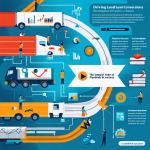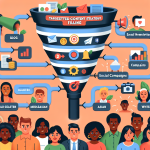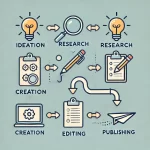Businesses need to employ strategies that not only attract customers but also guide them through a seamless journey toward conversion. One such strategy is the use of content pipelines, which are essential in building a consistent, goal-driven approach to engaging with potential customers. These pipelines are designed to be plug-and-play, making them ideal for business owners looking to implement a structured, yet flexible, content system based on their unique business goals and objectives.
Whether your aim is to educate your audience, nurture leads, or close sales, content pipelines break down these goals into actionable steps that span the entire buyer’s journey, addressing customer needs at every stage. This article will explore how business owners can effectively harness content pipelines to boost conversion rates and achieve sustainable growth.
Why Content Pipelines are Plug-and-Play
Content pipelines offer a streamlined, adaptable approach to content creation and distribution, allowing businesses to easily align their content with specific objectives. By organizing content creation around key business goals—such as increasing brand awareness, driving customer engagement, or enhancing conversions—business owners can ensure that every piece of content serves a specific purpose.
These pipelines can be customized and deployed with minimal effort, making them a “plug-and-play” solution for businesses of any size. Once implemented, content pipelines automatically guide potential customers through a structured process that moves them from awareness to decision-making, ensuring that all their needs are met along the way.
The best part? Content pipelines can be adjusted to fit your business strategy as it evolves. Whether you’re scaling up or shifting focus to a new market segment, content pipelines can be adapted to reflect these changes, ensuring that your content remains relevant and effective.
Breaking Down Content Pipelines Across the Buyer’s Journey
A well-constructed content pipeline aligns with the buyer’s journey, which typically consists of three key stages: awareness, consideration, and decision. Each stage requires a specific type of content designed to address the customer’s needs and move them closer to conversion.
- Awareness Stage
- At the awareness stage, your goal is to educate your audience about a problem they may not even know they have. Content created at this stage should focus on delivering value through educational blog posts, how-to guides, infographics, and informative videos. These pieces should position your brand as a trusted resource while subtly introducing the solutions your business offers.
- By utilizing content pipelines in the awareness stage, you can ensure a steady flow of top-of-the-funnel content designed to attract visitors and capture their interest.
- Consideration Stage
- In the consideration stage, potential customers are evaluating different options to solve their problem. This is where your content needs to dive deeper, offering comparisons, product demos, case studies, and customer testimonials that help build trust. It’s important to highlight your unique selling proposition (USP) and explain why your solution is the best fit for their needs.
- A content pipeline focused on the consideration stage will automatically prioritize content that speaks to the customer’s concerns and demonstrates the value of your product or service, making it easier for them to move forward in the decision-making process.
- Decision Stage
- The decision stage is where your audience is ready to convert into paying customers. At this point, your content should be designed to give them the final push. Techniques like limited-time offers, free trials, detailed FAQs, and ROI calculators can be extremely effective in this stage. Make sure your calls-to-action are clear and compelling, guiding the customer toward making the purchase.
- With an optimized content pipeline for the decision stage, business owners can rest assured that their content will deliver the right message at the right time, helping to convert prospects into loyal customers.
Optimizing Content Pipelines for Business Goals
The strength of content pipelines lies in their ability to align with specific business objectives. Whether your goal is to increase traffic, generate leads, or boost conversions, content pipelines can be fine-tuned to ensure that your content delivers measurable results. By focusing on goals like customer acquisition, nurturing leads, or enhancing the overall customer experience, you can create a tailored approach that drives growth.
Business owners can also set measurable KPIs (key performance indicators) within their content pipelines, making it easier to track progress and optimize strategies as needed. Tools such as Google Analytics or CRM software can provide insights into how well your content is performing at each stage of the buyer’s journey, allowing for data-driven decisions to refine and enhance the pipeline over time.
Engaging Customers Through the Entire Journey
Content pipelines are not only about delivering information but also about engaging with your audience at every touchpoint. By providing interactive content, such as quizzes, calculators, or personalized recommendations, you can create a dynamic experience that keeps your audience engaged throughout their journey.
Follow-up content, such as emails, social media posts, or targeted ads, can be automated through content pipelines, ensuring that your business stays top-of-mind even after a customer has made their initial decision. This continuous engagement helps build loyalty and encourages repeat business.
Measuring the Impact of Content Pipelines
Implementing content pipelines is just the first step—measuring their impact is critical to ensuring long-term success. Business owners can analyze various metrics to assess the effectiveness of their content pipeline, such as conversion rates, bounce rates, time spent on page, and lead-to-customer ratios.
Advanced analytics tools can help track how well content is performing across different stages of the buyer’s journey, providing valuable insights that can inform strategic adjustments. By measuring the effectiveness of each stage, business owners can identify areas of improvement and optimize their content pipeline to maximize results.
The Power of Plug-and-Play Content Pipelines
Content pipelines are a powerful, plug-and-play solution for business owners looking to streamline their content strategy. By aligning content with business goals and guiding customers through the buyer’s journey, businesses can drive higher conversion rates and improve overall customer satisfaction. The flexibility and adaptability of content pipelines make them an invaluable tool for scaling content efforts while ensuring that each piece of content serves a strategic purpose.
As you continue to refine your business strategy, consider integrating content pipelines to enhance your marketing efforts, engage with your audience more effectively, and ultimately boost your conversion rates. With the right content pipeline in place, you can turn casual web visitors into loyal customers, all while achieving your business objectives efficiently.
Related Posts:



















